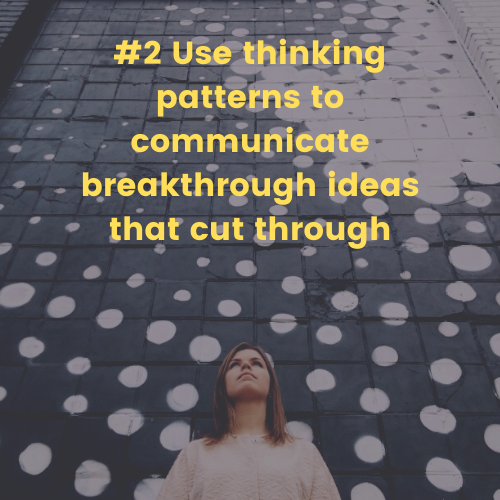#2 – Use patterns to communicate ideas that cut through
Structured thinking storyline patterns help you go from complexity to clarity fast.
My colleague Gerard and I have been helping executives from almost all backgrounds communicate complex ideas for a long time.
You might imagine that when we get together over a beer and a gin and tonic that our conversation goes places that yours might not.
We of course share tales about the challenging stories we have helped untangle, the interesting clients we have worked with and the times when our clients ‘nail' their presentations.
We particularly love sharing when our clients' audiences agree and quickly approve their recommendation, provide them with the funding they need, or allow their project to change direction so they can add more value.
We do also drift into the more technical aspects of our work.
A few years ago one of these conversations was pivotal.
We realised we were both doing the same thing that nobody else did.
We would listen to a client tell us about their situation and within a couple of minutes the structure for that story would form in our minds.
By that, we don't mean the corporate template, a list of topics or a decision to use Word or PowerPoint.
We mean the structure of the messaging.
We thought it would be a fun exercise to see if we were each using the same structures, or were they hugely varied?
We were bemused to find there were common threads: seven to be exact, which we codified in our book The So What Strategy.
You, however, might think the idea of having seven storyline patterns to use as a reference for most of your communication is a stretch.
Let me outline four reasons why these patterns work. In our experience, these patterns
- Push us to deliver messages that not only resonate but are founded in rock-solid logic
- Cover most executive communication
- Take us from complexity to clarity
- Speed us up. Dramatically.
I'll run them through in more detail one by one.
#1 – Push us to deliver messages that not only resonate but are founded in rock-solid logic
Think of situations when you have been persuaded.
The message resonates with you and is easy to grasp, even if the material is complex.
The main message is transparent and intriguing.
You can step through the material seamlessly and understand the ideas that are being conveyed.
This is because the thinking that underpins the ideas being communicated is rock solid.
And there is no better place to look for a rock-solid thinking framework than Aristotle.
The notion of using Aristotle's logical ideas to frame communication was first recorded by a Scottish academic, William Minto in the late 1800s.
He suggested that we could use inductive and deductive logic to frame communication.
The idea was finessed by someone with the same surname – Barbara Minto – whom I assume is a descendent.
Barbara coined the term the Pyramid Principle while working at McKinsey in the 1960s when she and a team were faced with the challenge of helping international consulting teams communicate better.
The idea here is that we can use logical structures to push us to think and be confident that our message is not only sound, but synthesised crisply.
So, how do these two forms help us convey complex ideas?
#2 – Cover most executive communication
On the surface, executive communication is varied.
It can be casual or formal; large group or small group; involve complex papers or PowerPoints; or face-to-face meetings, stand ups or huddles.
These things are all true.
However, executive communication isn't as complex as it seems.
There are a relatively small number of reasons why we communicate. Broadly, we need to:
- Explain why something is a good idea
- Describe actions that need to be taken
- Outline findings or progress
- Share past results
- Or, perhaps a mix of these things
So, if we look at the common threads, we can see how inductive and deductive logic might help us frame these situations.
An inductive grouping could explain why something is a good idea, describe what actions need to be taken, outline progress or share past results.
A deductive structure could provide a framework for communicating when a mix of these is needed. We could build a case for a recommendation and then, once the audience is persuaded, offer a set of actions for implementing that recommendation.
Both forms allow room to prepare long or short communication to any type of audience in any professional format.
So, the next natural question becomes, how do these two logical frameworks relate to the structures that Gerard and I were doodling over our drinks?
#3 – Take you from complexity to clarity
That feeling of ‘knowing' the answer and being able to doodle it onto the back of an envelope (or a beer mat?) is seductive.
To make the point in such a small space you must know the idea so clearly there is no clutter, just substance.
The great thing with the patterns that Gerard and I have now been using for decades is that they fit in a very small space while still covering lots of ground.
Our three grouping structures enable you to clarify a wide range of situations
- Action Jackson – for action plans, whether they be a list of instructions or a complex strategy
- The Pitch – for proposals and recommendations, whether they be engaging your team to take a particular path or communicating with a senior leadership team (even a Board)
- Traffic Light – for updates and compliance stories, again whether the story is simple or complex
Our three deductive structures offer many ways to frame your next recommendation
- Close the Gap – for improvement recommendations where you need to educate your audience on a new way of thinking about the solution
- Houston, we have a problem – for explaining how to solve a problem that you must first introduce to the audience because they don't know it is a problem yet
- To B or not to B – for explaining which option is best
- Watch out! – for countering emerging risks when things have been going well but you see ‘rocks ahead' and want to explain how to navigate around them.
#4 – Speed you up. Dramatically
The more I use these patterns and the more I see my clients use them, I am delighted to see how much more quickly they can get to the right point for their audience.
I see teams go from 15 hours' combined effort to prepare a steering committee paper that led to a lengthy and convoluted meeting without a decision to a very different situation.
These same teams cut their prep to about 2 hours and get a decision after a 15 minute meeting.
I see data analysts culling their 50 page PowerPoint down to just two pages, which get approved.
I see general managers (vice presidents) go from being so frustrated they take their teams' papers home each weekend and rework them themselves to almost putting down their red pen.
They tell me they can brief their teams in about 30 minutes and then offer only minor suggestions on the 10 page paper their team has drafted.
I could go on, but you get the idea.
If you would like to see some of these changes in your own work I encourage you to get a copy of The So What Strategy.
It includes ideas for using the patterns yourself as well as introducing them to your team.
We also offer free access to the Clarity With Impact course, which develops these ideas further.
I hope these tips have helped you and have more for you in Tip #3, where I offer ideas to help you communicate so that your audience's eyes don't glaze over.
Talk soon,
Davina Stanley
Next step - Learn more about the So What Strategy
This short and powerful book provides a go-to strategy to help you clarify your thinking so you can communicate complex messages clearly. The So What Strategy framework has been tested on thousands of professionals and is proven to be suited to the vast majority of professional communication settings.

This Tip was prepared by Davina Stanley, founder of The Clarity First Program and author of The So What Strategy.
Davina has been helping experts communicate complex ideas for more than 20 years.
She began this work when a Communication specialist at McKinsey & Company and has since helped experts of all kinds strengthen their communication skills.
She lives in Sydney Australia, having previously lived and worked in Hong Kong, Tokyo and New York.




